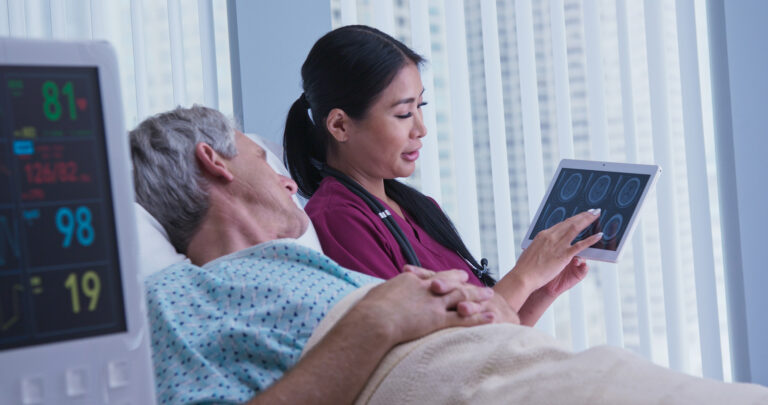
Sarah Anderson is a health, environment, and science reporter at Northwestern University’s Medill School of Journalism and a Ph.D. chemist.
In January, actor and comedian Bob Saget, 65, died from accidental blunt head trauma, according to the final report from the Orange County Sheriff’s Office. He likely hit his head on a surface in his hotel room and passed away in his sleep, according to a statement from his family. Saget’s tragic death grabbed headlines. It was also a reminder of the severity of head injuries, especially for older adults.
Compared to other age groups, people age 75 and older experience more hospitalizations and death due to traumatic brain injury, according to the most recent data from the Centers for Disease Control and Prevention (CDC).
Head injuries and older adults
Older adults are especially susceptible to head injuries because they are more likely to suffer a fall, says Stacie Levine, MD, chief of Geriatrics and Palliative Medicine at the University of Chicago Medicine.
Falls can be dangerous. Older adults may develop an unsteady walk, experience dizziness due to delays in the body’s blood-pressure-regulation signals, or take medications that cause low blood pressure — all of which can lead to falls and potential head injuries, Levine says.
An impact to the head can jostle the brain, causing a concussion. Or an impact may lead to a more serious injury that involves bleeding, such as a tear in a vein that bridges the brain and the skull. As the brain shrinks with age, these bridging veins become more fragile, making head injuries in older adults more likely to result in bleeding, says Nicole Reams, MD, a neurologist and director of the multidisciplinary concussion clinic at NorthShore University HealthSystem.
This bleeding can be life-threatening. Blood that accumulates in the space between the brain and the skull places pressure on the brain, which may damage vital structures that control breathing and heartbeat, Reams says.
Head injury symptoms
Ideally, in the aftermath of a head injury, another person should monitor symptoms closely. Older adults who live alone might ask someone in the area to check on them or at least have a family member or friend call them, Levine says.
People with head injuries may experience mild headaches, sensitivity to light or sound, nausea, and fatigue. If someone has a concussion, they should see a doctor within a few days to be diagnosed and learn about proper care, Levine says.
If an injured person is stable and their symptoms are not getting worse, doctors may recommend rest and sleep, Reams says. “It is vital to monitor after a head injury at least for a couple of hours for stability of symptoms and signs,” she says. “After the patient seems stable, sleep is encouraged as deeper stages of sleep, in particular, have been shown to aid in the brain’s recovery process following injury.”
On the other hand, some red flags warrant a trip to the emergency room, including suffering a seizure upon impact, spontaneous unconsciousness lasting longer than one minute, repeated vomiting, severe headaches, and numbness or weakness in the arms or legs (especially on one side of the body).
In most head injuries, symptoms arise immediately and rarely deteriorate. But in some circumstances, symptoms emerge over the course of days or even weeks following an impact, so it’s important to remain alert for any signs of deterioration that indicate a more dangerous injury, such as a bleed in the brain, Reams says.
Preventing head injuries
Of course, the safest head injury is the one that doesn’t happen. “To prevent a head injury, you have to start with preventing the fall to begin with,” Levine says.
As the greatest risk factor for falls in older adults is a previous fall, a healthcare practitioner should evaluate people who have fallen to make sure they have the right footwear and walking support, she says.
To manage dizziness upon waking, older adults should get out of bed gradually. Levine suggests that they pause after swinging their legs over the side of the bed and move their arms around to get their blood flowing before standing up. The CDC offers suggestions for additional fall interventions, which include exercise programs, home modifications, and clinical approaches.
Older adults taking blood thinner medications should monitor their blood counts, because of an increased risk of bleeding. This condition can make a brain bleed more traumatic, says Sheri Dewan, MD, a neurosurgeon at Northwestern Medicine.
While healthy, active older adults might be less concerned about an increased risk from falling or medications, they should follow basic safety techniques like wearing a seatbelt in the car and wearing a helmet during activities like biking and skiing, Dewan says.
If a head injury does occur, experts say: When in doubt, check it out.
“We know that geriatric traumas, in general, result in a greater risk of disability and poor outcomes in older adults compared to their younger counterparts,” Levine says. “So, number one is being aware that a head injury should be taken seriously.”
If you experience changes after a head injury, give your doctor a head’s up and discuss any symptoms.
“People with loss of consciousness for more than one minute, weakness or numbness on one side of the body, recurrent vomiting, or difficulty walking should go to the emergency room,” Reams says. “But even given these clear recommendations, symptoms of head injuries can be different in different individuals and can change over time. If there’s ever a head injury that worries you, get medical attention immediately.”








